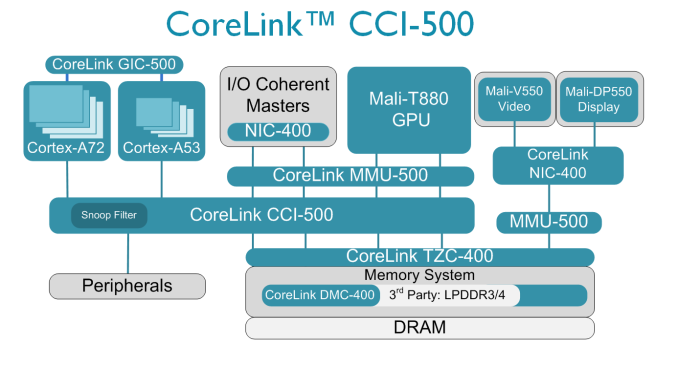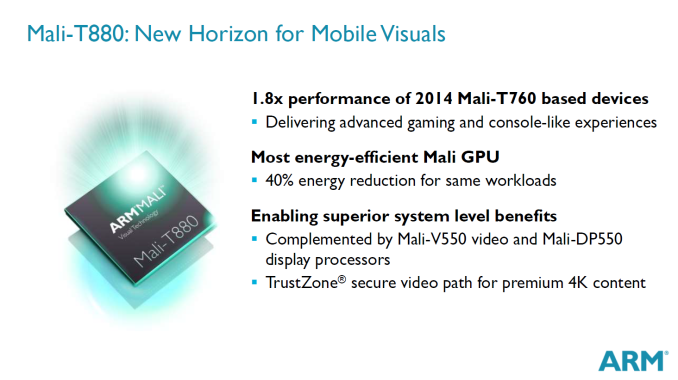ARM Announces Cortex-A72, CCI-500, and Mali-T880
by Andrei Frumusanu on February 3, 2015 5:30 PM EST- Posted in
- Smartphones
- Arm
- Mobile
- Mali
- Cortex A72
- CCI-500
- Mali T880

Today ARM is announcing three brand-new premium IP designs targeted at high-end mobile SoCs. We're still only starting to get widespread commercial availability of ARM's latest generation of SoCs, which includes the Cortex-A57 in big.LITTLE configuration coupled with the A53 as little cores, and the newest T760 Mali GPUs. But, while those designs are still ramping up through offerings from Samsung, Qualcomm, HiSilicon and co. this year, ARM isn't staying still and already looking forward to 2016 and beyond.
Cortex-A72 - a new high end core
At the center of today's announcements a new high-end performance core which succeeds the A57 in flagship devices. ARM was very vague about the architectural characteristics of the new design, disclosing for now only estimates of the chip's performance and power targets. ARM promises a 3.5x sustained performance increase over the A15 generation of SoCs while remaining in the same power budget. One has to note that we're talking about performance targets on TSMC's 16nm FinFET+ node versus previous nodes such as 28 and 20nm, which in itself should bring large clock and power advantages.
The A72 targets roughly 1.9X the sustained performance of current 20nm A57 SoCs, meaning the Exynos 5433 and the Snapdragon 810 can be taken as the base for comparisons. ARM doesn't yet mention peak performance so we may be talking about overall power efficiency gains that enable future SoCs to throttle much less. ARM will be divulging more information on the architecture of the A72 in the coming months, and we're hoping to have a better picture on the actual IPC and efficiency gains of the new flagship core by then.
The Cortex-A72, being a "big" core, can be partnered up with the already existing A53 LITTLE core architectures. ARM has said in the past that the A53 took in-order designs to new heights, and while work on a successor is underway, it seems that for now we'll be sticking with the A53 architecture for a while longer.
HiSilicon, MediaTek and Rockchip are listed among more than then launch partners which have already licensed the Cortex-A72 processor, so expect to see a variety of vendors offering the new ARM IP in 2016.
CoreLink CCI-500 SoC interconnect
It's been over 3 years since ARM initially announced their CCI-400 (Cache Coherent Interconnect), which saw widespread usage as the corner-stone technology enabling big.LITTLE heterogeneous multiprocessing in all consumer SoCs from the Exynos 5410 to the latest Snapdragon 810. While ARM also offered high-end alternatives such as the CCN-5XX (Cache Coherent Network) range of interconnects, these were targeted more at server-applications and not meant for mobile SoCs in smartphones or tablets.
The CCI-500 is a large upgrade over the CCI-400 as it introduces a variety of new functionality over its predecessor. The largest change in functionality is the addition of a snoop filter on the interconnect itself. Until now snoop control was only possible between CPUs within a single cluster. The addition of a snoop filter on the interconnect allows for power efficiency benefits as the amount of transactions when doing cache lookups is decreased, enabling both reduced overhead on the interconnect and also higher idle residency times on the CPU cores. This reduced overhead also frees up memory bandwidth on the interconnect, and ARM claims this enables for 30% better memory performance on the CPU ports.
The new interconnect also doubles up on its system bandwidth: We now have twice the number of ACE (AXI Coherency Extension) ports, enabling usage of a maximum of four CPU clusters (instead of the two that are possible with the CCI-400). We'll be continuing to see the usage of only two clusters in mobile designs, but the new IP gives licensees the flexibility to deviate according to their needs.
The increased bandwidth and numbers of ports on the interconnect also opens up the possibility of quad-channel memory controllers, resulting in 128-bit memory buses. The Snapdragon 805 was the first mobile product to feature such capability, although Qualcomm used a non-cache-coherent interconnect in their design.
Mali T880 GPU
Lastly, ARM also announced a new member of the T800 series of Mali GPUs. In addition to the T820, T830 and T860 comes the T880. ARM was again light on details of what this new configuration brings, only promising a 1.8x increase performance over 2014 Mali T760 GPUs and a 40% reduction in energy consumption for the same workloads.
With today's announcements, ARM appears to be addressing its weaknesses in mobile SoCs by focusing on sustained performance and efficiency of its big core architecture. We also have the much needed upgrade in the memory/interconnect subsystem and an expansion in its GPU IP offering.
Source: ARM
















49 Comments
View All Comments
OreoCookie - Tuesday, February 3, 2015 - link
It'll be curious to see what the architecture is like. Given the performance claims, the architecture has to be significantly wider, though.Jumangi - Wednesday, February 4, 2015 - link
A bunch of unprovable PR numbers for chips consumers won't see for 18 months yet probably....yawn.darkich - Wednesday, February 4, 2015 - link
And some simple math reveals the single core Geekbench performance on par, if not better than Broadwell U, and much better that that Core M joke.It is also much better than the 20nm Cyclone.
And we're talking at least quad core setup here, and sub 3W thermal design!
Absolutely amazing
azazel1024 - Wednesday, February 4, 2015 - link
Where are you getting sub-3w thermal with that performance? Their numbers suggest 3.5x the performance of an A15, but with only 75% better energy efficiency at the same workload as "2014 devices", which I assume to mean the A15 as well. Those numbers are also comparing 28nm TSMC versus 16nm FINFET+ TSMC, which is probably 100% of the power efficiency gain there.Since some of that is likely through higher clocks, the efficiency advantage is likely lower at the clock speeds necessary to yield a 3.5x gain in performance.
Considering the A15's TDP, this means a full up A72 implementation is likely >>>3w when actually preforming at 3.5x the performance of an A15. That sounds more like a 6-8w TDP when performing at those levels, but when throttled way back after hitting temp caps, its probably only performing 1.5-2x the performance of an A15 to stay within 2-3w or so to be in a phone.
That means more power than Broadwell M (a lot more) even if the performance somehow actually manages to be higher.
V900 - Thursday, February 5, 2015 - link
WOOT!!!!Just absolutely amazing?!? Surely you mean THE GREATEST TRIUMPH IN CPU DESIGN EVARR!!! Did anybody call the Nobel committee yet?!?
Seriously though: We're talking about a quad core CPU that only has launched on paper yet. We have no idea on how it'll perform besides very rudementary figures from the designer(s). It's also around 18 months away from being in an actual product.
The fact that you think it's 'absolutely amazing' that a design 18 months into the future beats Apples Cyclone (which has been out for over a quarter) and Intels Core M (which is out now) is perhaps a abusing the words 'absolutely amazing' no?
darkich - Friday, February 6, 2015 - link
No its not abusing when you consider the fact that this CPU will be set into many cores and run inside your phone. .and be more frugal than today's phone CPU's.And "much" (around 80%) better than Cyclone, that is a two core setup.
Intel otoh, is on a superior process even now, and isn't able to beat it even with a $270 CPU, with 2-3 times higher power consumption.
So yeah, amazing.
Alexey291 - Friday, February 13, 2015 - link
You really need to trust PR statements a liiiiittle less.Speedfriend - Thursday, February 5, 2015 - link
"And some simple math reveals the single core Geekbench performance on par, if not better than Broadwell U, and much better that that Core M joke."Not sure on your simple math...
Single core Geekbench
Exynos 5433 = 1178
Supposedly A57 will give 1.84x the performance, so 2167
Core M in HP Envy get 2500 Single core Geekbench
try again please
darkich - Friday, February 6, 2015 - link
Haha, talk about cherry picking!!The lowest Exynos score and the highest Core M score.
While in reality the Exynos goes up to 1400 and Core M starts from 1800(depending on the model..you used a high end thermally unrestricted one that sips up to 20W - read the review on notebookcheck.com - and costs over 250$!!)
Now you try again please
Daniel Egger - Wednesday, February 4, 2015 - link
Right, MediaTek and A72... the company known for flooding the market with cheap Cortex-A7 cores. True OctaCore my ass.